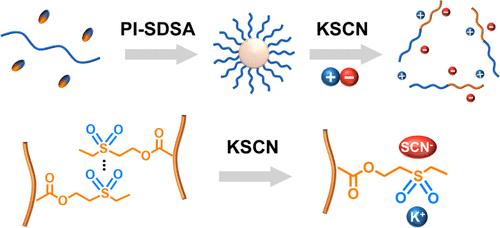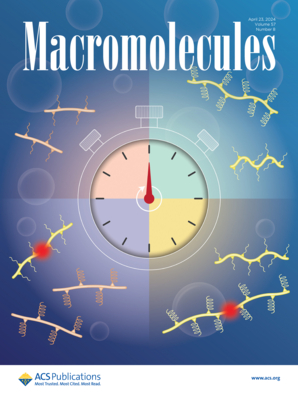Polymerization-Induced Sulfone-Bond-Driven Self-Assembly
IF 5.2
1区 化学
Q1 POLYMER SCIENCE
引用次数: 0
Abstract
Sulfone bonding refers to dipole–dipole interactions between sulfone groups, which have been long overlooked. Herein, sulfone bonding was employed for the first time as the driving force for the self-assembly of block copolymers via a polymerization-induced sulfone-bond-driven self-assembly (PI-SDSA) strategy. The presence of sulfone bonding in a sulfone-functionalized monomer was first confirmed by scanning tunneling microscopy break junction measurements at the single-molecule level. Successful PI-SDSA was achieved in toluene, and the polymerization kinetics confirmed the polymerization-enhanced sulfone bonding as the driving force. The PI-SDSA was demonstrated to possess a peculiar monomer/solvent library by the successful PI-SDSA of a series of sulfone-containing monomers in solvents with varying dipole moments. The as-prepared sulfone-functionalized polymer assemblies manifested unique salt-responsiveness because of the competitive ion–dipole interactions between the ions and sulfone groups, enabling the salt-responsive payload release. The use of sulfone bonding as the driving force for self-assembly has provided a new perspective for both the polymerization-induced self-assembly and the self-assembly of block copolymers and will inspire the design of stimuli-responsive supramolecular materials.

聚合诱导的砜键驱动自组装
砜键是指砜基团之间的偶极-偶极相互作用,长期以来一直被忽视。本文首次将砜键作为嵌段共聚物自组装的驱动力,采用聚合诱导砜键驱动自组装(PI-SDSA)策略。砜功能化单体中存在的砜键首先通过扫描隧道显微镜在单分子水平上的断裂结测量得到证实。在甲苯中成功地实现了PI-SDSA,聚合动力学证实了聚合增强砜键是驱动聚合的动力。通过在不同偶极矩的溶剂中成功地对一系列含砜的单体进行PI-SDSA,证明了PI-SDSA具有独特的单体/溶剂库。由于离子和砜基团之间的竞争性离子偶极子相互作用,所制备的砜功能化聚合物组件表现出独特的盐响应性,从而使盐响应有效载荷释放。利用砜键作为自组装的驱动力,为嵌段共聚物的聚合诱导自组装和自组装提供了一个新的视角,并将启发刺激响应超分子材料的设计。
本文章由计算机程序翻译,如有差异,请以英文原文为准。
求助全文
约1分钟内获得全文
求助全文
来源期刊

Macromolecules
工程技术-高分子科学
CiteScore
9.30
自引率
16.40%
发文量
942
审稿时长
2 months
期刊介绍:
Macromolecules publishes original, fundamental, and impactful research on all aspects of polymer science. Topics of interest include synthesis (e.g., controlled polymerizations, polymerization catalysis, post polymerization modification, new monomer structures and polymer architectures, and polymerization mechanisms/kinetics analysis); phase behavior, thermodynamics, dynamic, and ordering/disordering phenomena (e.g., self-assembly, gelation, crystallization, solution/melt/solid-state characteristics); structure and properties (e.g., mechanical and rheological properties, surface/interfacial characteristics, electronic and transport properties); new state of the art characterization (e.g., spectroscopy, scattering, microscopy, rheology), simulation (e.g., Monte Carlo, molecular dynamics, multi-scale/coarse-grained modeling), and theoretical methods. Renewable/sustainable polymers, polymer networks, responsive polymers, electro-, magneto- and opto-active macromolecules, inorganic polymers, charge-transporting polymers (ion-containing, semiconducting, and conducting), nanostructured polymers, and polymer composites are also of interest. Typical papers published in Macromolecules showcase important and innovative concepts, experimental methods/observations, and theoretical/computational approaches that demonstrate a fundamental advance in the understanding of polymers.
 求助内容:
求助内容: 应助结果提醒方式:
应助结果提醒方式:


